ALLIGATOR
BEHAVIOR page 2b: SOCIAL SIGNALS AND BELLOWING 2 1 3 4 5 6 7 8 9 10
This
page was born 12/27/2003. Rickubis designed it. (such as
it
is.) Last update: 11/29/2012
Images
and contents on this page copyright © 2001, 2012 Richard M.
Dashnau
Alligators,
although they are ectothermic and also equipped with a small
brain, exhibit
a surprising diversity in their responses to their environment
and to each
other.
They are for more complex than mere animated logs or
12-foot-long
eating machines. This group of pages show some
of what I've been able to
see in the years I've
been volunteering (September of 2001 thru March of 2020) at
Brazos Bend State
Park.
November
03, 2002Still
ANOTHER
cool, wet weekend!!!. I'll just say here that the water is
high throughout the park--higher than it's been for a long
time.
The cold, rainy weather kept me
from getting many pictures today.
However, over the week before, I finally decided to stop further
attempts
to recover more of the Alligator Gar bones, and work with what I
had. I
completed
this, and built a case for it. I brought the spine to the park,
where it was set behind the skull. I left the park without
taking
any pictures of my two projects together! So, maybe next
week.
For
now, I'm going to relate something I saw a few weeks ago at the
park. And
besides, I'm sure everyone is asking: "Hey, Rick! What about the
alligators?"
The
picture YEP I'M CONFUSED (below) is a
frame
from a series of short video clips I shot with the Olympus C-700.
I was
at New Horseshoe lake, and talking with some visitors about the
fair-sized
alligator floating near the center. There was a larger one on the
far shore.
As I was standing there...perhaps
30 minutes or so the larger alligator
sort of "drifted" a little along the shoreline. Then it
started to
move towards my left, still near the shoreline. As it did this,
the smaller
alligator (perhaps
around 8-10 feet; the larger one was 10-12 feet) slowly
turned and began moving towards the larger one. That's when I
started filming,
since I was sure the two alligators were aware of each
other, and were
moving *because* of each other. As the two alligators neared
each
other, I started talking to the visitors, and was telling them of
probable
social signals we would see--that
is, perhaps a snout raised, or the tail-arch
and sunken back posture--that might signal submission or
aggression.
---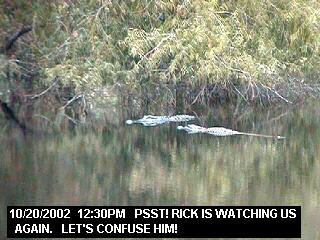 -
-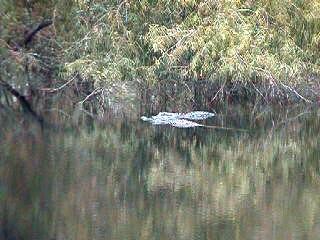 ---
---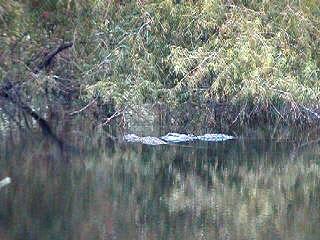 --
--
YEP, I'M CONFUSED
PUSH 1
PUSH
2
However,
as the alligators got even closer to each other, NONE of this
happened.
As far as I could see, there were no visible signals at all!
The
smaller alligator "swam across the bow" of the larger one, it even
seemed
like there was a slight bump (PUSH 1, above), and then it swam in
front
(PUSH 2, above), and then turned
towards the larger alligator and moved
alongside (PUSH 3, below). Finally. the smaller
alligator moved
so its head was near the base of the larger one's tail, and the
larger
alligator moved
away and towards the center of the lake (PUSH 4, below).
It stopped after swimming about 20 feet away from the smaller
alligator.
It was almost as if the two alligators had exchanged
guard positions. As
in all non-violent interactions between alligators, the movements
were
slow and evenly-timed.
-------------------------------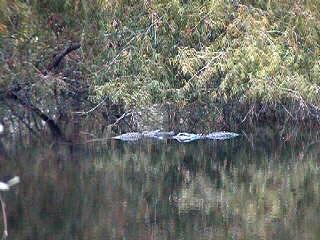 ------------------------------
------------------------------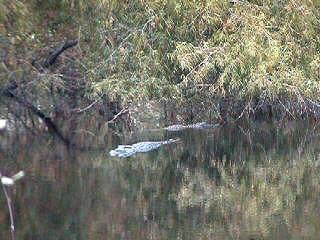
PUSH
3
PUSH
4
To
see the 3 clips showing this interaction, click the following
links: clip1(517
kb) clip2(491
kb) clip3(514
kb)
July
14, 2002 FINALLY, we've gotten
some
rain. This is not said to trivialize the flooding that has
happened in
other parts of Texas. However, my area, and Brazos Bend State
Park,
is
actually about 11 inches less-than-normal for rainfall for this
time of
year. The park needed rain. This picture (MORNING VISITOR, above)
shows
a medium-sized (about 8-feet long)
alligator that came ashore right in
front of me at Elm Lake. There was some activity this
morning, with
an unseen alligator doing two headslaps about 15 minutes apart
(well, there
were
two headslaps, but possible from different alligators) not far
from
me; and some movement back and forth across the lake by a few
other alligators.
One crossed the trail about 75 yards
from me, too far away for a
decent picture. One of the large males made an appearance,
but everything
was pretty passive. The following account may seem long, but
I think
it's
interesting. It was to me, and this is my page, so there you are.
I wanted to record this, anyway.
Wild
rice is growing rapidly throughout the park, including the area in
and
around Elm Lake. I've been wondering about cutting some of it
down, in
order to give a clearer view of the lake.
One of the few advantages
of the water levels dropping was that it would be easier to reach
out further
and cut through the rice at the water's edge. I'd
planned to
try to cut some of the
rice this weekend, using a scythe. Although
it had rained, I figured that I'd try my original plan anyway,
mostly to
see how difficult this project would be. Unfortunately the higher
water
level
meant that I'd be working in deeper water than I'd planned.
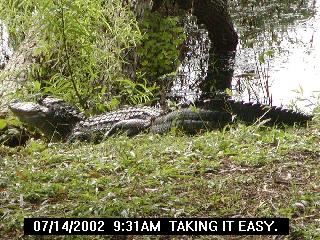
MY MORNING VISITOR
The
first spot I cleared was not too difficult, and was completed
without incident.
I will
take a moment to review some things I've mentioned on these pages
about
alligator behavior. A large part of alligator communication
happens while
the alligator is in the water.
Two particular signals are especially
noticeable. These are the "headslap" and the "tail wash".
The former
involves the alligator quickly raising its upper jaw out of the
water,
rapidly
dropping its lower jaw under the water; and then quickly slapping
its upper jaw down, making a loud pop/splash noise, which is
sometimes
accompanied by a grunt, or short bellow. The
latter signal is the rapid
side-to-side movement of the tail in the water, which makes loud
splashing
noised; and which is sometimes also joined by rapid movement of
the alligator
(from
tail propulsion). Both of these signals are loud, and
relatively
violent; and very noticeable, even by humans. Both of these
signals
frequently cause alligators to respond; sometimes by
leisurely investigation,
sometimes by a more rapid movement towards the commotion, and
sometimes
by challenging behavior. I've read this in various sources,
and also
observed
some of this myself.
So, part
of my plan for this rice project was to cut during the hot part of
the
day, after lunch, when the alligators have been
scarce,
that is, hidden from view. I assumed that most of them
were
near the islands, and otherwise hidden from the sun by staying in
the water
away from the trails. With the temperatures as warm as they had
been, and
with the receding water level,
they probably were at optimum operating
temperature for most of the day. So, although I'd seen a few
alligators
in the morning, I didn't see any when I started cutting rice
today, and
didn't
expect to. I was cutting near my second area, and as I worked, I
noted that I was in deeper water than I wanted to be (up past my
knees),
that visibility was poor (too much plant
life
covering the water), and that as I swung the scythe, it was
hitting
the water with loud splashing noises. I decided to
work
quickly, and was going to swing just a few more times. I swung,
and splashed,
and suddenly something large splashed
into
the water across from me, about 20 yards away. I, in my
hip-waders,
was out of the water before the last drops
finished
falling
(I was being...discrete. Yeah, that's the ticket....). I
turned and looked back into the plants (this area has a
thick
growth of water lilies) and saw a bow wave pushing the plants
aside as
something moved rapidly off to my left. Yes, it
was
a pretty good-sized alligator, which stopped moving and looked at
me.
Well, that was enough for me. I stopped working in that area
and moved
further down the trail. The next area I cut was without incident,
but I
worked within sight of one of the piers, where some visitors were
standing.
I figured anything moving towards
me from their direction would get their
attention, and I'd be alerted. But, nothing happened.
Finally,
I moved to the area where I saw the alligators earlier this
morning. I
did see one about 6 feet long about 30 yards
from
where I intended to work, but I drove the John Deere gator
near it, and
parked on the shore. I started working, and
after
each 3 swings or so, I'd look around the lake. I could not
avoid
the loud splashing as I entered the deeper (about 3
feet
deep)
water. I looked up once, and there was my "friend" (the one
I'd parked the Gator near), or one the same size,
about
20 feet away, and slowly approaching, while looking directly at
me.
I've
often noticed what an alligator looks like
when
its attention is on me. Usually, I don't mind, and act with
respect.
When I am standing in the water (or near it, but
immobilized
by vegetation),
it can be unnerving. I decided that my plan was not
feasible at this time, especially not working alone. So, I slowly
left
the water, and I walked over to the last pier, where some park
visitors
were. I'd already pointed out for them the alligator approaching
me, and
when I joined the people on the pier, 3 more alligators appeared,
and swam
towards where I'd been working.
They stopped further away than the
first one did (about 50, 70, and 80 feet away) and faced where I
had been.
Two of them swam by the pier slowly, but with attention focused on
my work
area. One came from behind ther first that had approached me
and
after a few minutes of slow movement towards the first alligator;
actually
chased it for a few minutes! But nothing more
happened between them.
All of these alligators were close in size, between 6 and 8 feet
long.
The
large male I'd seen there this morning did not appear. I
decided
I was finished with
cooking myself in my hip-waders,
and
returned to my car. Of course, since I was actually working
in and
near the water with a large implement, I didn't have
my camera
on me, and so
couldn't record any of this visually.
Lessons
from this experience: Don't splash in water known to be
inhabited
by alligators. Therefore, do not SWIM in water inhabited
by alligators. Even
"smaller" alligators are not intimidated by the
fact that I'm human, upright, and close to their
size
once the proper stimuli (violent splashing) had been
applied. Even
though the first alligator
did seem to stop approaching when
I stood back and faced it, showing that I was not an alligator, it
stayed
interested in the area, possibly looking for
more
stimulus (splashing). The other
alligators didn't seem to care what else
was in the area. They were still interested in
where
I had been, even after I'd stopped for some time.
June
30, 2002 It had been raining all
weekend.
Not steadily, but enough to make things wet, and the air close and
sticky.
I hadn't been at the park very long, before it started raining on
me.
I was near the water station on Elm Lake Trail, and between
that point and
to about 75 yards past the first pier I saw 8 alligators lying still
in
the water. For at least 15 minutes, all the alligators
were stationary,
and facing the trail (see RAINY MORNING, below). Two smaller
alligators
were very close to the shore, and one of them is the rickubiscam
shot for
this week. After this brief
period of stillness-during which the rain paused
for a short time-some of the alligators began moving around. There
were
two larger alligators (probably males) in the group. Two of
the midsize
alligators (about 6 feet long) started moving first. The
alligators slightly
tilted their heads as they swam, showing their lips above the
surface,
but keeping the head almost horizontal. They also
showed most of their
upper back and tail as they moved at a leisurely pace. Eventually,
all
the alligators had scattered.
The
rain finally stopped, around 10:00. I wandered the trails, which
were clear
of visitors, for a while. Sometime later I, with a couple
others,
went to visit one of our new alligator nests. Alligators
build nests during
this month, and two have nested within easy sight of one of our
most accessible
trails; the Creekfield Trail. The first nest is about 10
minutes'
walk fromthe Visitor's Center,
and close enough to be seen easily from
the trail, yet far enough away from the trail for the mother to be
undisturbed
(and therefore not moved to vigoruously defend her nest).
Although
we are
far enough away from her nest, the female is definitely keeping
an eye on us (see SHE'S WATCHING ME, below). She is actually
behind
the nest (from the viewpoint of the trail). The nest is the
pile of old
grass and logs in front of her. This female has put some
pretty large
pieces of wook into her nest. If her nest remains unharmed
(unfortunately,
there are many raccoons in the area she
chose for her nest.), she will
guard it for the 60 days required to incubate her eggs. This is
one of
the largest females-if not the largest-that I've seen at
the park.
It's not possible to be 100-percent
sure of an alligator's sex unless one
does a physical examination (probe of the anal vent); but
nest-guarding
behavior is usually not shown by male American Alligators.
----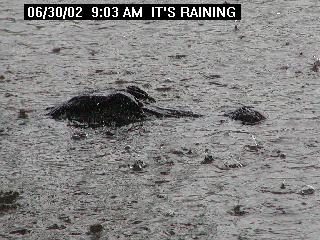 ----
----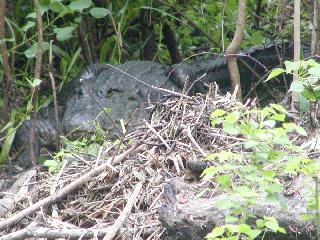 -
-
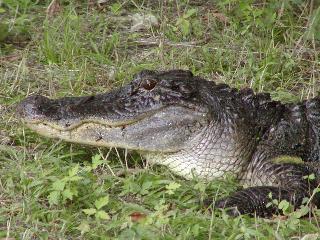
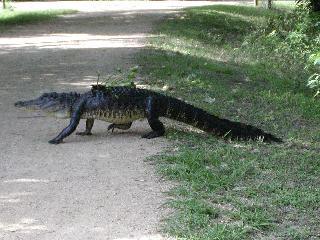
RAINY MORNING
SHE'S
WATCHING ME ------ -
WHAT A CUTIE!
----
-----
---
THERE SHE GOES
June
02, 2002 This morning, I was on
the trail by Elm Lake. I'd been watching two alligators that were
close
to shore. since I figured that they'd be crossing the trail soon (to
enter
Pilant Lake).
They didn't. However, I was talking to a family who
were visiting the park, and talking about the two alligators. As I
watched,
the large male alligator I'd been watching raised it's back out of
the
water and neared shore. It had been totally submerged except for its
head.
I had the small group of people step back a little, so that he might
exit
the water (another couple of people happened
to be passing by). We were
watching the large male, when a young boy, about 4 or 5 years old, I
guess,
pointed BEHIND me, and said "LOOK AT THE ALLIGATOR!". I turned my
head,
and sure
enough, there was one coming across the path. It stopped when
it noticed us. (WHAT A CUTIE, above), and rested for just a
minute
or so. Then it got up and crossed the trail. (THERE SHE
GOES, above). I
refer to it as "she" because it was smaller, and also because its
head
wasn't that massive. This alligator walked straight towards the
large
male which had been waiting in Elm
Lake, and when she entered the water
(almost walking onto the male), the male turned and swam off, and
she followed.
Only afterwards did I realise that the male had raised its body out
of
the
water at almost the same time that the female must have been walking
towards the trail- - -from the other side, that is, from Pilant
Lake. Remember,
I'd thought that he was about to leave the water
since he was showing
more of his back and head.
May 25,
2002 I saw a little social interaction
between some alligators this morning. A few alligators had gathered
around
the last pier on Elm Lake, mostly because they wanted to try to
steal
from
the people fishing there. One of these was a large male, at least 10
feet
long. As I watched, this male once leisurely swam over towards a
smaller
alligator (about 6 feet long) and caused it
to move away. This was all
done at a leisurely pace. Then, this male moved from where it had
been
for some time (30 to 60 minutes), and went around the bend of the
lake.
When it did, it
encountered another alligator, about 8 feet long. The two
alligators faced each other, from about 20 feet apart, for about 15
minutes.
--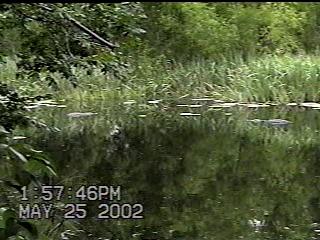 ---
---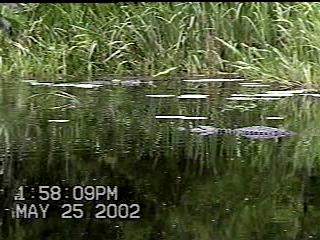 ---
---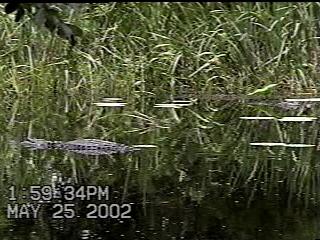
FIRST
CONFRONTATION
MOVE
ASIDE!
BIG
ONE MOVES PAST
After
this
time, the larger alligator (which I assumed was the one that "owned"
this particular territory), slowly moved towards the smaller one(FIRST
CONFRONTATION, ABOVE, or flv
video
313kb). The 8-
footer moved quickly towards the
shore, and the large one stopped moving (MOVE
ASIDE,
ABOVE, or flv
video
632kb). It seemed to drift
past a bit (BIG
ONE MOVES PAST, ABOVE), and slowly
turned
towards
the smaller one, which "made a break" and swam with some haste away
from-but
close to- shore and around the bend, in the direction of the pier (BETTER
PART OF VALOR, BELOW,
or flv video
564 kb).
-----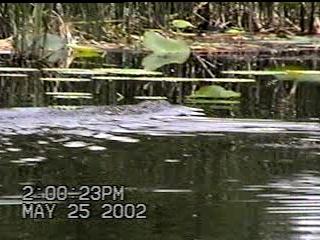 --------
--------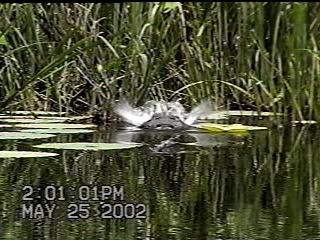
THE
BETTER PART OF VALOR
THIS IS *MY* DOMAIN!
The
large
alligator began to pursue, that is, it increased speed briefly, then
stopped. After this, it moved towards the shore, and assumed
"bellowing
position". It remained this way for a few
minutes, and then performed a
"short-bellow/headslap" (growl/headslap)(this sounds like a short,
deep
growl punctuated by a headslap, but review of the video shows a
brief vibration
of the
back, as in bellowing. I believe that this vibration, combined with
the headslap, must be detectable underwater for some distance)( MY
DOMAIN, ABOVE, or flv
video
634kb). After this, it
remained
at rest (no further
display, no bobbing, no tail arch, no high flotation).
And, this page
shows alligators at the park, on land, near various landmarks at the park.
Go
back to my home page, Welcome
to
rickubis.com
Go
back
to the See
the World page.
 -
- ---
--- --
--



 ----
---- -
-





